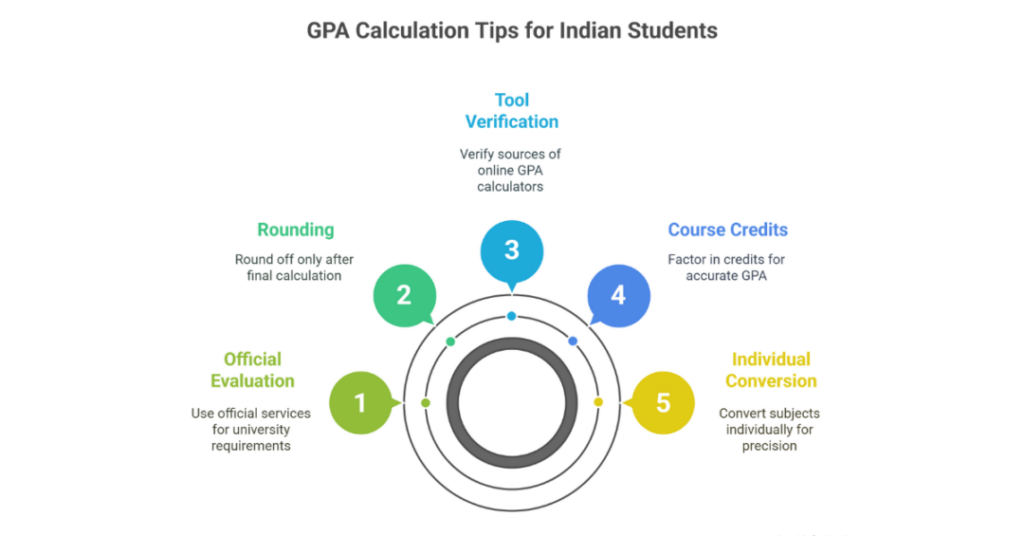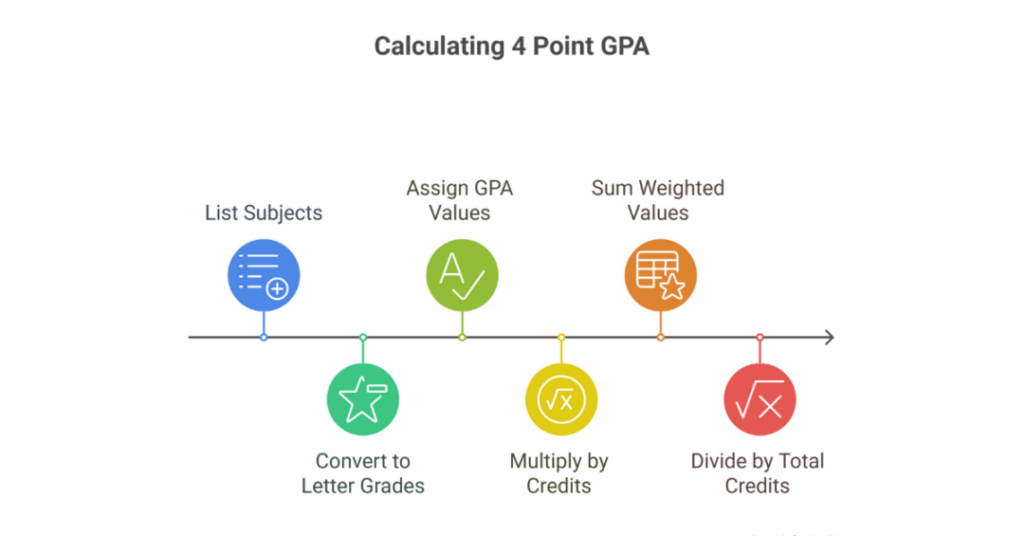14 July 2025
5 minutes read
GPA Meaning Explained: A Complete Guide for Indian Students

Key Takeaways
- GPA meaning is crucial for Indian students; it’s how global universities assess your academic performance beyond percentages.
- A 3.5+ GPA boosts your chances for scholarships, financial aid, and top university admits abroad.
- Use tools to convert your percentage to GPA and build a strong profile with Ambitio’s expert guidance.
Did you know that a GPA of 3.5 or above on the 4.0 scale can unlock scholarships, financial aid, and top grad schools, yet most Indian students don’t even know how GPA is calculated? That’s because our grading system runs on percentages, not grade point averages.
So when it’s time to apply abroad, confusion hits hard. What’s a good GPA? How do I convert my marks? Relax. Once you understand the basics of GPA calculation, everything, from college admissions to raising your GPA, gets easier.
What is GPA?
GPA, or Grade Point Average, is a numerical score that reflects your overall academic performance on a scale between 0 and 4.0. It’s widely used by high schools, colleges, and universities, especially in the US, to assess eligibility for scholarships for international students, financial aid, and college admissions.

Your GPA is calculated by dividing the total number of grade points earned by the total number of credits attempted. A good GPA, like 3.5 or above, can improve your chances to apply for a master’s or PhD. GPA can be weighted or unweighted, and many universities use GPA calculators for transparent evaluations.
GPA Meaning in the Indian Education Context
GPA meaning in the Indian education context can be confusing, as Indian schools and colleges use percentage grades, not the 4.0 GPA scale. However, to apply for a master’s or PhD abroad, students must calculate GPA, often using a GPA calculator, to match the GPA grading system used by many universities.
GPA is a numerical average of academic grades, calculated by dividing grade points by the total number of credits. A high GPA like 3.5 or above can unlock scholarship, financial aid, and college admissions. Knowing the GPA meaning and how GPA is calculated using weighted or unweighted scales is crucial for global success.
Grade Point Average vs. Percentage: Key Differences for Indian Students
Understanding the GPA meaning is crucial for Indian students planning to study abroad. While we use percentages, most global universities rely on the 4-point GPA scale to evaluate overall grades and eligibility.
Here’s a breakdown of the key differences between GPA and percentage systems to help you convert grades easily and plan better:
| Aspect | Percentage System (India) | Grade Point Average (GPA) System |
|---|---|---|
| Grading Scale | Out of 100 marks | Scale between 0 and 4 (4-point scale) |
| Highest Grade | 100% | 4.0 GPA |
| Type of Grading | Absolute percentage | Letter grade or number of grade points |
| Calculation Basis | Final marks achieved | GPA = Total Grade Points divided by Total Credits |
| Used In | Most Indian schools and colleges | High schools and universities abroad |
| Types of GPA | N/A | Weighted GPA, Unweighted GPA, Cumulative GPA |
| Weight Factor | Not applicable | Varies by courses you took, credits, and difficulty |
| Conversion Complexity | Straightforward | Requires tools to calculate your GPA or weighted GPA scale |
| Minimum Eligibility | Varies (often 60%) | Minimum GPA of 3.0 often needed for admission |
| Role in Admissions | Less standardized | GPA determines your eligibility for scholarships, financial aid, and programs |
| Transparency | Subjective between institutions | GPA system makes education more transparent and allows students to track performance |
| Flexibility | Less flexible in grading scale and conversion | GPA is also used to compare across programs and institutions |
If your GPA is 3.14, for example, it could be competitive, but a 3.5 GPA or the highest GPA improves your chances. Use an unweighted GPA scale or calculate weighted GPAs based on the school you attend, credit weight, and grades obtained to stay competitive when applying to universities that accept students based on GPA.
How to Calculate and Convert Indian Percentage to GPA (with Examples)
GPA meaning often confuses Indian students because our system uses percentages, not GPA. But when applying abroad, knowing how to calculate your average and convert it to the 4-point scale is essential, especially since your GPA is the key used for admissions, scholarships, and aid.

Here’s how to convert your Indian percentage to GPA in simple steps:
- Understand the Scale
Most international universities use a 4.0 scale, where the highest GPA is 4.0. Indian percentages must be converted using a scale that aligns with this system. - Use the Common Conversion Formula
A rough estimate:
(Your Percentage / 100) × 4 = GPA
Example: 75% becomes (75/100)×4 = 3.0 GPA. - Consider the Grading Policy of the University
GPA is used differently by many high schools and colleges. Some may prefer weighted scale conversions depending on course difficulty and grades and percentages. - Weighted vs. Unweighted GPA
- Unweighted GPA doesn’t factor in course difficulty—used in high school GPA systems.
- Use a weighted GPA scale if your school assigns extra points for advanced or honors subjects.
- Cumulative GPA vs. Final GPA
- Cumulative GPA includes all courses during your time at university.
- Final GPA may reflect only your last semester or year, depending on what the school uses.
- Assess GPA in Order to Improve
- If you have a low GPA, don’t panic. Focus on average grades obtained, choose better electives, and plan your semesters wisely.
- To raise your GPA, improve performance in high-credit courses, as GPA is divided by the total credits.
- Example Conversion Table Percentage Estimated GPA 85–100% 4.0 (Excellent) 70–84% 3.0–3.7 60–69% 2.0–2.9 Below 60% 1.0–1.9
- Why GPA is So Important
Whether your GPA is 3.0 or lower GPA, it plays a vital role in college admissions, scholarships, and academic planning. It helps students to have their academic performance evaluated fairly across different systems. - Pro Tip
For subjects like “12 for English” or electives, ensure high scores to balance your overall grades and scores and get a good GPA in high school.
By knowing your GPA meaning, choosing the right strategy, and tracking your overall GPA, you can confidently apply abroad, even if you’re coming from India’s grades and percentages system.
Why is GPA Important for Indian Students Applying Abroad?
Understanding the GPA meaning is crucial for Indian students applying abroad, as overall GPA refers to your academic consistency, not just how high you scored once. Many universities rely on your GPA to assess potential, offer scholarships, and make admissions decisions.
Since GPA is so important, knowing the different types of GPA, like average unweighted GPA or GPA used in high schools, helps. In certain situations, your GPA gives clarity where percentages can’t, ensuring fair global comparison.
GPA Score Requirements for Top Universities
GPA meaning goes beyond just numbers; it directly impacts your eligibility for top universities. While many institutions consider your full profile, your GPA score, especially in certain situations, can make or break your application.
Here’s a table showing minimum GPA requirements for some top global universities:
| University | Country | Minimum GPA Requirement | Notes |
|---|---|---|---|
| Harvard University | USA | 3.8 – 4.0 | Extremely competitive; holistic review still applies |
| Stanford University | USA | 3.7+ | Strong GPA + research/internships preferred |
| University of Oxford | UK | 3.7+ (US scale) | Equivalent to UK First Class Honours |
| University of Toronto | Canada | 3.3 – 3.7 | Depends on program; high school performance matters |
| ETH Zurich | Switzerland | 3.5+ | GPA important in STEM programs |
| University of Melbourne | Australia | 3.0 – 3.5 | GPA + relevant coursework required |
| National University of Singapore | Singapore | 3.5+ | Competitive; strong academic background expected |
| TU Munich | Germany | 2.5 – 3.0 (on German scale) | GPA conversion required for Indian students |
Conclusion
In the end, understanding the GPA meaning is more than decoding numbers; it’s about translating your academic journey into a globally recognized format. Whether you’re targeting Ivy Leagues or top European schools, your GPA can shape your chances. But grades alone aren’t everything; a strong profile matters too.
That’s where Ambitio steps in.
From GPA conversion to personalized profile building, we help you stand out beyond just numbers.
Ready to turn your GPA into a global opportunity?
Join Ambitio Elite today and build a profile that speaks louder than your transcripts.
FAQs
What is the difference between a weighted and unweighted GPA?
Weighted GPA accounts for the difficulty of courses, giving more weight to advanced classes, while unweighted GPA treats all courses equally.
How is cumulative GPA calculated?
Cumulative GPA is calculated by dividing the total number of grade points earned by the total number of credits taken across all semesters.
Why is GPA important for college admissions?
GPA is a key factor in college admissions as it provides a standardized measure of a student’s academic performance and potential.
Can a low GPA affect my chances of getting a scholarship?
Yes, a lower GPA can limit scholarship opportunities, as many scholarships have minimum GPA requirements.
How does a GPA of 3.0 compare to a GPA of 3.5?
A GPA of 3.5 is considered stronger and can improve eligibility for more competitive programs and scholarships compared to a 3.0 GPA.
Do all schools use the same GPA scale?
No, schools may use different GPA scales, including a standard 4-point scale, a weighted scale, or percentage grades.
Can I improve my GPA if it’s low?
Yes, improving your GPA is possible by performing well in future courses, especially those that carry more credits or are more advanced.

You can study at top universities worldwide!
Get expert tips and tricks to get into top universities with a free expert session.
Book Your Free 30-Minute Session Now! Book a call now




























